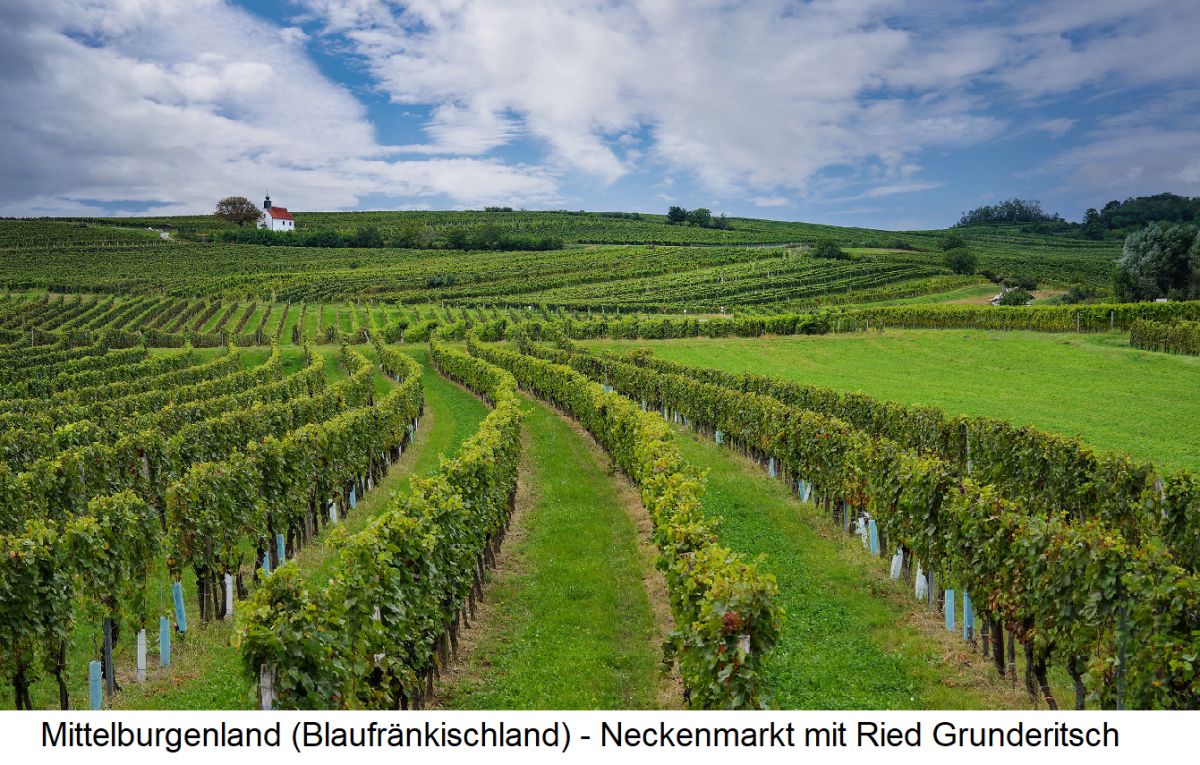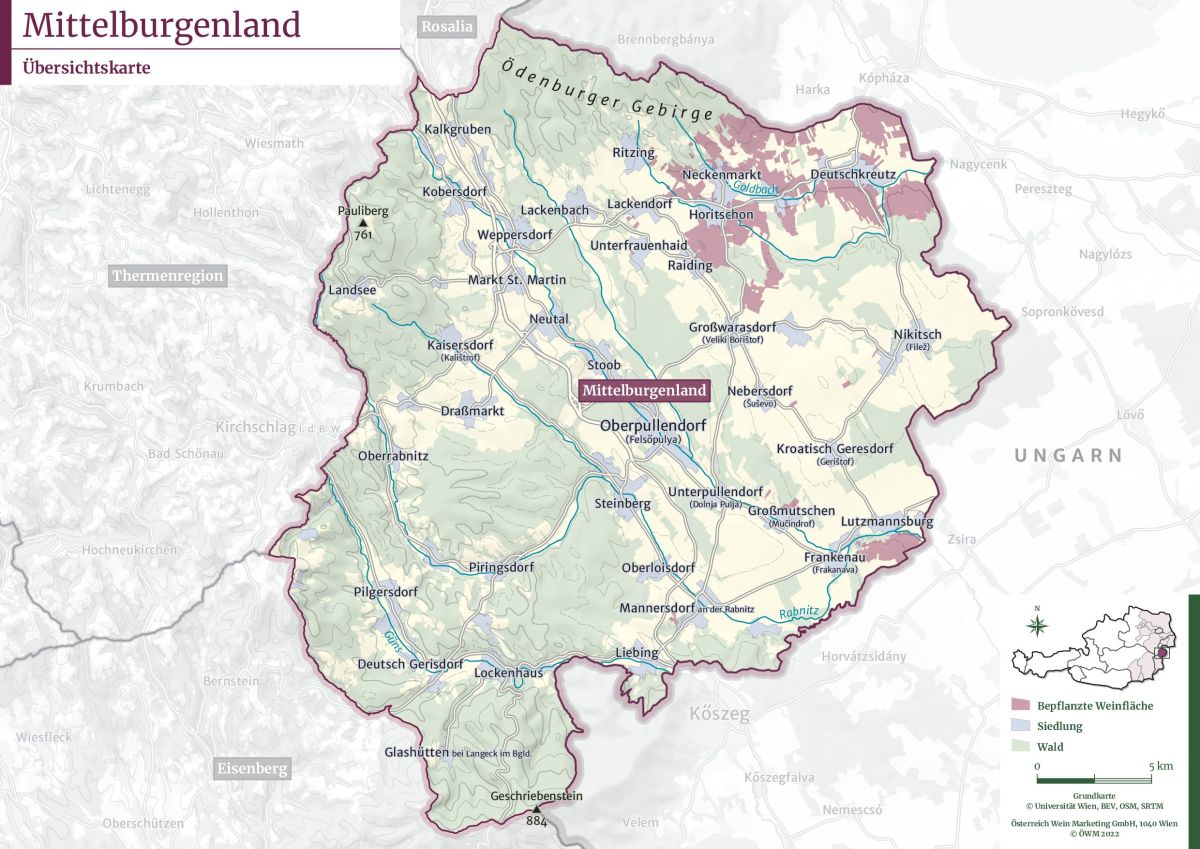Results
2,284 Results
Loading more Results ...
Loading more Results ...
| Mittelburgenland |
Description to Mittelburgenland
One of the six specific wine-growing regions in the Austrian province or generic wine-growing region of Burgenland. In 2016, a reorganisation took place with some changes to the names and area boundaries. However, Mittelburgenland was not affected by this; the name and boundaries remained the same.

History
The Celts and Romans were already cultivating vines here. According to legend, the Frankish Emperor Charlemagne (742-814) also visited this region. Cistercian monks from Burgundy brought the grape varieties Blaufränkisch and Pinot Gris (Pinot Gris) with them in the Middle Ages and cultivated viticulture.
Climate & soils
The three ranges of hills Ödenburger Gebirge in the north, Bucklige Welt in the west and Günser Bergland in the south provide protection from cold winds. Warm, Pannonian climatic influences flow in from the east and the nearby Lake Neusiedl, like all bodies of water, has a climate-regulating effect. The predominant soil types are sand, loam and sometimes gravel formations with good water retention. A varietal study at the Federal Office of Viticulture in Eisenstadt established that the origin of Mittelburgenland can be determined analytically. This is possible on the basis of wine constituents, in particular minerals and flavourings. The very high content of the health-promoting phenolic compound resveratrol is striking.
Wine-growing communities & vineyards
The hilly, wooded region covers the entire central part of the province between Lower Austria in the west and Hungary in the east. Well-known wine-growing communities include Deutschkreutz, Frankenau, Kroatisch Geresdorf, Kleinwarasdorf, Horitschon, Lackenbach, Lutzmannsburg, Neckenmarkt, Nikitsch, Ritzing, Unterfrauenhaid and Unterpetersdorf. Well-known vineyards (sites) are Dürrau, Gfanger, Hochäcker, Hochberg, Kart and Kirchholz.

Grape variety index
In 2022, the vineyards covered 2,035 hectares of vines. Compared to 2017 with 2,104 hectares, this was a reduction of 69 hectares (3.3%). The proportion of red wine varieties is 92%, white wine varieties 8%. Central Burgenland is Austria's red wine-growing region. Blaufränkisch dominates with more than half, which is why it is also known as "Blaufränkischland". It is followed by the Zweigelt, Merlot, Grüner Veltliner and Cabernet Sauvignon varieties:
Grape variety
|
in Austria
|
colour |
HA
|
%
|
HA
|
%
|
| Blaufränkisch | - | red | 1.046 | 51,4 | 1.151 | 54,7 |
| Zweigelt | Blauer Zweigelt, Rotburger | red | 497 | 24,4 | 461 | 21,9 |
| Merlot | - | red | 127 | 6,3 | 122 | 5,8 |
| Grüner Veltliner | Weißgipfler | white | 71,4 | 3,5 | 87 | 4,1 |
| Cabernet Sauvignon | - | red | 78,2 | 3,8 | 82 | 3,9 |
| Syrah | Shiraz | red | 37,5 | 1,8 | 38 | 1,8 |
| Roesler | - | red | 24,3 | 1,2 | 20,6 | 1,0 |
| Chardonnay | Morillon - not used in Bgld | white | 24,2 | 1,2 | 15,7 | 0,7 |
| St Laurent | . | red | 21,6 | 1,1 | 22,8 | 1,1 |
| Welschriesling | - | white | 18 | 0,9 | 20,6 | 1,0 |
| Blue Burgundy | Pinot Noir, Pinot Noir | red | 17,7 | 0,9 | 22,2 | 1,1 |
| Cabernet Franc | - | red | 13,1 | 0,6 | 9,4 | 0,4 |
| Sauvignon Blanc | Muscat Sylvaner | white | 7,8 | 0,4 | 7,6 | 0,4 |
| Blue Burgundy | - | red | 6,5 | 0,3 | 10,3 | 0,5 |
| Pinot Blanc | Pinot Blanc, Klevner | white | 5,8 | 0,3 | 6,4 | 0,3 |
| Muscat | Yellow M., Red M. / Muscat Blanc | white | 5,6 | 0,3 | 2,3 | 0,1 |
| Müller-Thurgau | Rivaner | white | 3,8 | 0,2 | 5,6 | 0,3 |
| Muscat Ottonel | - | white | 3,1 | 0,1 | 2,5 | 0,1 |
| Souvignier Gris | - | white | 3 | 0,1 | - | - |
| White Riesling | Riesling Rhine Riesling | white | 2,5 | 0,1 | 2,8 | 0,1 |
| Rathay | - | red | 2,2 | 0,1 | 2,1 | |
| Furmint | - | white | 1,9 | 0,1 | - | -- |
| Gold muscatel | - | white | 1,3 | 0,1 | - | |
| Scheurebe | Seedling 88 | white | 0,9 | - | 1,4 | 0,1 |
| Traminer | Gewürztraminer, Roter T., Gelber T. | white | 0,8 | - | 0,5 | - |
| Grey Burgundy | Pinot Gris, Ruländer | white | 0,8 | - | 0,6 | - |
| Muscaris | white | 0,7 | - | - | - | |
| Goldburger | - | white | 0,6 | - | 0,9 | - |
| Blossom muscatel | - | white | 0,5 | - | - | - |
| Rose muscatel | - | white | 0,4 | - | - | - |
| Frühroter Veltliner | - | white | 0,3 | - | - | - |
| Bouvier | - | white | 0,2 | - | 0,4 | - |
| Blauer Portugieser | - | red | 0,1 | - | 0,9 | - |
| Rotgipfler | - | white | 0,1 | - | 0,1 | - |
| Neuburger | - | white | - | - | 0,3 | - |
| Roter Veltliner | - | white | - | - | 0,2 | - |
| remaining varieties | - | white/red | 12 | 0,6 | 8 | 0,4 |
WHITE VARIETIES |
163 |
8 |
161 |
8 |
||
RED VARIETIES |
1.872 |
92 |
1.944 |
92 |
||
TOTAL |
2.035 |
|
2.104 |
|
DAC system
From the 2007 vintage, the origin-controlled quality level Mittelburgenland DAC was introduced. All other quality wines must be marketed with the Burgenland designation of origin, while regional wines must be marketed under the wine-growing region designation Weinland Österreich:
The wines must have been made from the quality wine grape variety Blaufränkisch. The indication of Großlage is not permitted; only a municipality and, in the second category, a vineyard may be indicated as smaller geographical units. The malic acid content may not exceed 0.5 g/litre and the residual sugar content may not exceed 2.5 g/litre. The red wine is available in three different categories:
Classic: The taste must be typical of the variety, fruity and spicy; the aroma must be typical of the variety; the colour must be a muted, strong red. The wine must be matured in traditional large oak barrels (no to barely noticeable wood tone) or in stainless steel tanks. The alcohol content must be at least 12.5 or 13% vol. The wines may not be marketed before 1 March of the year following the harvest.
Vineyard (site): The flavour must be typical of the variety, fruity, spicy and full-bodied. Ageing must take place in traditional large oak barrels or used barrique barrels (no to light wood tone). The alcohol content must be at least 13 or 13.5% vol. The wines may not be marketed before 1 September of the year following the harvest.
Reserve: The flavour must be typical of the variety, fruity, spicy and full-bodied. Ageing must take place in traditional large oak barrels or barriques (noticeable to dominant wood tone). The alcohol content must be at least 13% vol. The wines must not be marketed before 1 January of the year following the harvest.
Producers
Well-known producers in the Mittelburgnland wine-growing region are Arachon T.FX.T, Bauer-Pöltl, Bayer Heribert, Draxler Andreas, Fuchs Christian, Gager Josef, Gesellmann Albert, Grenzlandhof Reumann, Heinrich Johann, Hofstädter Johann, Hundsdorfer Anton, Iby Anton, Iby-Lehrner, Igler Hans, Igler Josef, Kerschbaum Maria, Kerschbaum Paul, K+K Kirnbauer, Kovacs Matthias, Lang Stefan, Lehrner Paul, Moritz Alfred, Pfneisl, Prickler Herbert, Reumann Josef, Strehn Monika, Szemes, Tesch Josef, Vereinte Winzer Blaufränkischland, Weber Rudolf, Weber Thomas, Wellanschitz, Weninger Franz, Wieder Juliana, Winzerkeller Neckenmarkt and Wohlmuth Gerhard. A well-known winegrowers' association is Eichenwald Weine.
Pictures: © ÖWM - Marcus Wiesner
Classified wine producers in Mittelburgenland 25
find+buy for Mittelburgenland 33
Recent wines 333
 Weingut Weninger GmbH
— Burgenland
2018 Mittelburgenland Ried Dürrau Blaufränkisch trocken
Up to 60.00 €
Weingut Weninger GmbH
— Burgenland
2018 Mittelburgenland Ried Dürrau Blaufränkisch trocken
Up to 60.00 €

 Weingut Weninger GmbH
— Burgenland
2017 Mittelburgenland Ried Dürrau Blaufränkisch trocken
Up to 60.00 €
Weingut Weninger GmbH
— Burgenland
2017 Mittelburgenland Ried Dürrau Blaufränkisch trocken
Up to 60.00 €

The most important grape varieties
More information in the magazine
- Wines with a special flavour Wine-growing regions in Austria: Eisenberg
- The land of Blaufränkisch Wine-growing regions in Austria: Mittelburgenland
- Delightful border region Wine-growing regions in Austria: Rosalia
- In Focus: Grüner Veltliner The elegant ones are coming
- Terroir and landscapes in Burgenland At the centre of the Blaufränkisch universe
- BEST OF Burgenland Much new on old shores
- Austria In Focus Burgenland
- Mittelburgenland DAC Fruity, spicy, unmistakable Blaufränkisch
- Travel diary Burgenland Travel diary Burgenland
- "We winegrowers need legal certainty in uncertain times" Interview: Alois Höllerer, "Happy Situation" initiative
